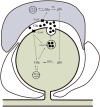Peripheral role of glutamate in orofacial pain
- PMID: 36440288
- PMCID: PMC9682037
- DOI: 10.3389/fnins.2022.929136
Peripheral role of glutamate in orofacial pain
Abstract
Glutamate is the principal excitatory neurotransmitter in the central nervous system. In the periphery, glutamate acts as a transmitter and involves in the signaling and processing of sensory input. Glutamate acts at several types of receptors and also interacts with other transmitters/mediators under various physiological and pathophysiological conditions including chronic pain. The increasing amount of evidence suggests that glutamate may play a role through multiple mechanisms in orofacial pain processing. In this study, we reviewed the current understanding of how peripheral glutamate mediates orofacial pain, how glutamate is regulated in the periphery, and how these findings are translated into therapies for pain conditions.
Keywords: glutamate; glutamate receptors; glutamate transporters; orofacial pain; trigeminal ganglion.
Copyright © 2022 Liu, Jia, Huang, He and Fan.
Conflict of interest statement
The authors declare that the research was conducted in the absence of any commercial or financial relationships that could be construed as a potential conflict of interest.
Figures



Similar articles
-
NMDARs mediate peripheral and central sensitization contributing to chronic orofacial pain.Front Cell Neurosci. 2022 Sep 27;16:999509. doi: 10.3389/fncel.2022.999509. eCollection 2022. Front Cell Neurosci. 2022. PMID: 36238833 Free PMC article. Review.
-
An electron microscopic description of glutamate-like immunoreactive axon terminals in the rat principal sensory and spinal trigeminal nuclei.J Comp Neurol. 1991 Jul 8;309(2):271-80. doi: 10.1002/cne.903090208. J Comp Neurol. 1991. PMID: 1679441
-
Morphological foundations of pain processing in dental pulp.J Oral Sci. 2020;62(2):126-130. doi: 10.2334/josnusd.19-0451. J Oral Sci. 2020. PMID: 32224566 Review.
-
Changes in vesicular glutamate transporter 2 (Vglut2) and vesicular GABA transporter 1 (Vgat1) in the orofacial pain and temperature perception pathway under low estrogen conditions.Neuro Endocrinol Lett. 2022 Jun 7;43(2):88-98. Neuro Endocrinol Lett. 2022. PMID: 35933616
-
Glutamate pharmacology and metabolism in peripheral primary afferents: physiological and pathophysiological mechanisms.Pharmacol Ther. 2011 Jun;130(3):283-309. doi: 10.1016/j.pharmthera.2011.01.005. Epub 2011 Jan 26. Pharmacol Ther. 2011. PMID: 21276816 Free PMC article. Review.
Cited by
-
Involvement of Oxidative Stress and Nutrition in the Anatomy of Orofacial Pain.Int J Mol Sci. 2023 Aug 23;24(17):13128. doi: 10.3390/ijms241713128. Int J Mol Sci. 2023. PMID: 37685933 Free PMC article. Review.
-
Special issue: Glutamate- physiology, pathology, therapy.Pharmacol Rep. 2024 Dec;76(6):1197-1198. doi: 10.1007/s43440-024-00670-w. Pharmacol Rep. 2024. PMID: 39511122 No abstract available.
-
Enhancing orofacial pain relief: α-phellandrene complexed with hydroxypropyl-β-cyclodextrin mitigates orofacial nociception in rodents.Naunyn Schmiedebergs Arch Pharmacol. 2024 Nov 4. doi: 10.1007/s00210-024-03561-2. Online ahead of print. Naunyn Schmiedebergs Arch Pharmacol. 2024. PMID: 39495266
-
Hyperexcitability of muscle spindle afferents in jaw-closing muscles in experimental myalgia: Evidence for large primary afferents involvement in chronic pain.Exp Physiol. 2024 Jan;109(1):100-111. doi: 10.1113/EP090769. Epub 2023 Dec 16. Exp Physiol. 2024. PMID: 38103003 Free PMC article. Review.
References
-
- AAOP (2022). The American academy of orofacial pain. Available Online at: https://aaop.org/ (accessed September 30, 2022).
-
- Alhilou A. M., Shimada A., Svensson C. I., Svensson P., Ernberg M., Cairns B. E., et al. (2021a). Nerve growth factor and glutamate increase the density and expression of substance P-containing nerve fibers in healthy human masseter muscles. Sci. Rep. 11:15673. 10.1038/s41598-021-95229-7 - DOI - PMC - PubMed
Publication types
LinkOut - more resources
Full Text Sources

